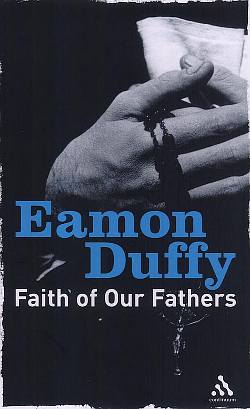 Etter konsilet kastet mange katolikker vrak på Kirkens tradisjoner, skriver Eamon Duffy. Duffy er ingen forsvarer av Kirken slik den hadde blitt i 1960, men han er samtidig svært kritisk til måten man kastet vrak på tradisjonen etter Konsilet – og at man ikke erstattet det man kastet med andre elementer fra Kirkens skattkammer. Han skriver mot slutten av sitt forord i boka ‘Faith of Our Fathers’:
Etter konsilet kastet mange katolikker vrak på Kirkens tradisjoner, skriver Eamon Duffy. Duffy er ingen forsvarer av Kirken slik den hadde blitt i 1960, men han er samtidig svært kritisk til måten man kastet vrak på tradisjonen etter Konsilet – og at man ikke erstattet det man kastet med andre elementer fra Kirkens skattkammer. Han skriver mot slutten av sitt forord i boka ‘Faith of Our Fathers’:
It is a mystery because by and large in the past Catholic theologians advocating change, even radical change, have been as anxious to invoke the notion of tradition as those seeking to maintain the status quo. At the heart of the ‘New Theology’ of De Lubac, Congar and the other theological midwives of the Council, was a passionate call to rediscover the tradition. They set about freeing the Church from the narrow straitjacket of a debased nineteenth-century neo-scholasticism by opening up the riches of the deep tradition of the Church, in the scriptures, the liturgy, the Fathers. For them the past was not a sterile cul-de-sac to be escaped from, but an inexhaustible well of Christian experience and wisdom, which liberated theology and the Christian imagination by demonstrating how diverse, subtle, endlessly inventive the Church has been, and is called to be, in her journey through time.
Within Ultramontane Catholicism, however, the notion of tradition had been in danger of narrowing to mean little more than the current Roman theology. Pio Nono’s notorious 1870 aphorism ‘I am the tradition’, was a telling reflection of the day-to-day reality of an increasingly powerful central authority, which strangled Catholic theology (and episcopal teaching) for a century. Most of the citations in the (rejected) draft declaration of faith drawn up for the Second Vatican Council by the Holy Office under Cardinal Ottaviani, for example, were from the writings and speeches of Pius XII and his immediate predecessors: no church document earlier than the Council of Trent was cited, and there were no quotations from scripture. Tradition had shrunk from being a cathedral of the Spirit to a storeroom in the cellars of the Holy Office.
The Conciliar reforms did a great deal to correct this sterile and authoritarian notion of tradition, to recover a sense of the variety and richness of the Christian past as a resource for the Christian present. But whatever the roots of reform, much of the practical liturgical, theological and catechetical reform carried out since the Second Vatican Council was informed by a search for immediacy or authenticity of experience, rather than attentive encounter with the diversity, depth and wisdom of the tradition. In place of a philistine authoritarianism, cut off from the riches and complexity of the Christian past by a mindset described as ‘non-historical orthodoxy’, we have tended to substitute a non-historical liberalism, which has even less to offer.
Reaction was inevitable, and drew strength from the fact that the years immediately before the Council proved to have been the high-watermark of institutional Roman Catholicism in Britain and North America. In the wake of the Council, thousands and priests and religious abandoned their vocations to marry, clerical recruitment plummeted, and Catholic practice eroded. Unsurprisingly, the blame for this institutional erosion was often laid at the door of post-Conciliar change. Accordingly, over the last 20 years there has been a growing call for ‘restoration’, endorsed at the highest levels of the Church, and manifesting itself in a revived clericalism and a strong-arm exercise of ecclesiastical authority which many find deeply alienating. ‘Tradition’ has become a fraught and difficult term, invoked by self-styled ‘traditionalists’, to call a halt to change and herald a return to the forms and mindset of the recent past, rather than as a resource for change.
The essays in this book were written out of a quite contrary conviction, that an understanding of the richness of the Church’s past is a liberation, not a straitjacket. The tradition offers us a point of vantage from which to criticize the present, certainly, but it is also a source of confidence in launching into the uncharted future. Cardinal Newman once famously declared that `in another world it may be otherwise, but here below to live is to change, and to be perfect is to have changed often’. The Church’s past, in all its complexity and contradictoriness, is abundant evidence that change, not stasis, is the sign of life. …
